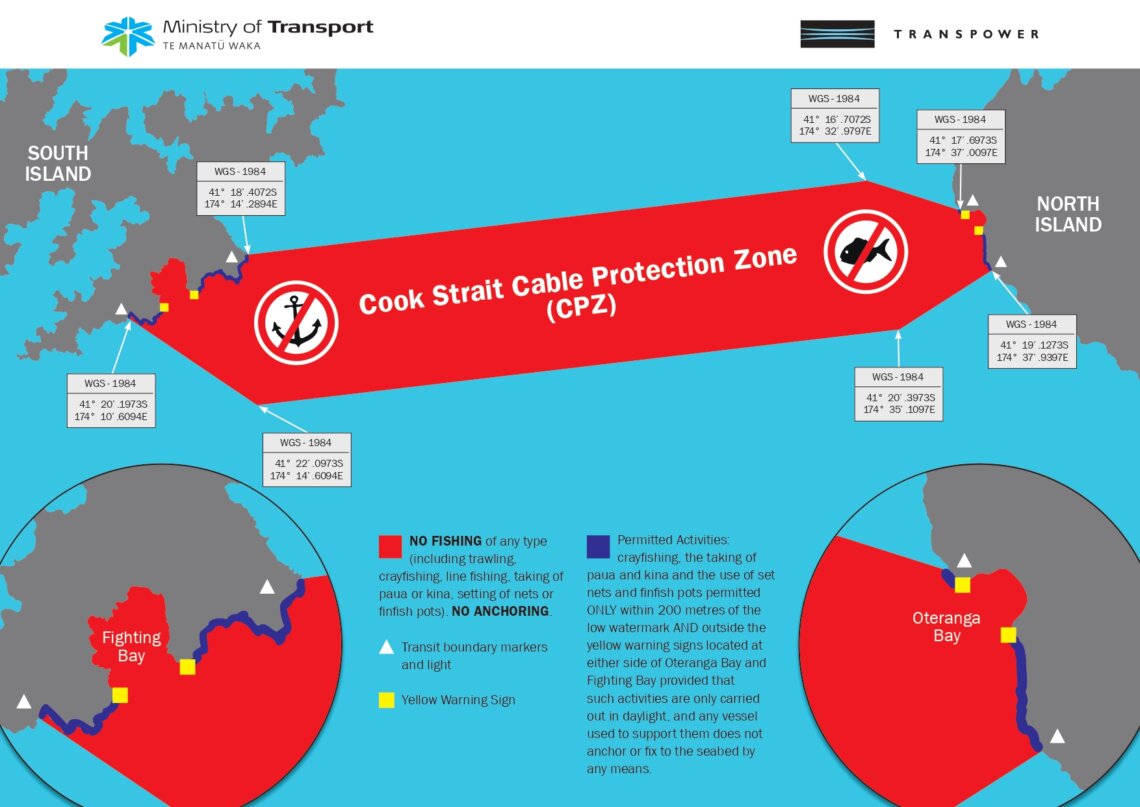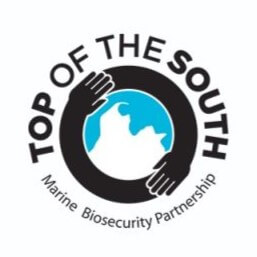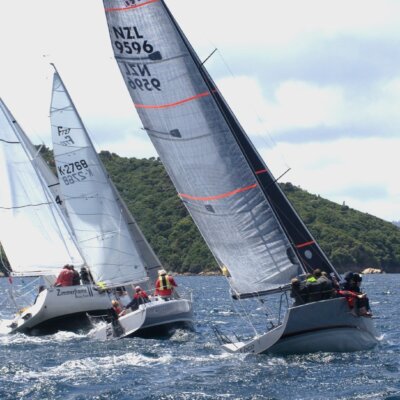Cook Strait Cable Protection Zone
The submarine cables that pass through the Cook Strait are vital to New Zealand’s electricity and communications systems and to the country’s economy. The Cook Strait Cable Protection Zone (CPZ) is there to protect them.
The high voltage power and fibre optic cables have suffered several instances of serious damage since installation and remain vulnerable to further fouling and damage.
Fishing & Anchoring are Illegal
All anchoring and fishing operations of any type, involving the use of a vessel of any size, are illegal within the Cable Protection Zone (CPZ). The CPZ includes the areas within Fighting Bay and Oteranga Bay.

Legislation
The Submarine Cables and Pipelines Protection Act 1996 (SCPPA) was passed by Parliament to improve protection of the cables. The SCPP Order 2009 and Amendment Order 2016 define the protected areas governed by the Act, including Area 7 that is the Cook Strait CPZ (see attached diagram).
Key penalties include those listed below. In addition to these penalties, anyone causing cable damage is liable under civil law for repair costs.
- $100,000 maximum fine for fishing or anchoring in the CPZ ($20,000 for non-commercial operators).
- $250,000 maximum fine for damaging a cable, whether wilfully or negligently.
- Forfeiture of a vessel or other property used in an offence may, upon conviction, be ordered by the Court.
What is Fishing?
Fishing includes but is not limited to trawling, crayfishing by any means, the taking of paua and kina, the use of set nets and the various methods of line fishing. Having any equipment that may be used for fishing or anchoring deployed over the side of a vessel in the CPZ is considered to be a fishing or anchoring operation (whether or not such equipment is fully deployed). Having a partly deployed net in the water in the CPZ (whether or not the trawl doors are in the water) or recovering a net onto a vessel in the CPZ are both examples of activities which the Courts have held to be fishing operations and therefore illegal when carried out within the CPZ.
Evidence of Fishing & Anchoring
Where there is evidence of deployment of a net, line, rope, chain or any other thing used in connection with a fishing or anchoring operation being suspended from or operated or towed by a ship, the law presumes fishing or anchoring to have been taking place unless the vessel operator can prove otherwise. This is a reversal of the normal onus of proof that applies in law.
The Patrol Vessel & Helicopter
Transpower have a patrol vessel and patrol helicopter providing 24/7 monitoring of the CPZ. The patrol vessel and helicopter are equipped to detect and record evidence of violations of the Act in the CPZ. The crews of both patrols are designated as protection officers under the Submarine Cables and Pipelines Protection Act 1996 and are authorised to respond in the event of a violation. The patrol vessel’s crew welcome enquiries at any time from the fishing community and will endeavour as far as possible to assist with information. They prefer to provide information to assist fishing vessels to keep within the law.
Protection Officers
The crews of Transpower’s patrol vessel Seapatroller and patrol helicopter are protection officers. Where there is reason to believe an offence is being committed, protection officers have the authority under the SCPPA 1996 to: –
- Order vessels to leave the CPZ. A fine of up to $10,000 may be imposed for failing to comply.
- Require vessel operators to identify their vessel, its master and owner, and provide any other relevant identifying information. A fine of up to $5,000 may be imposed for failing to comply.
- Uplift and seize equipment that is set or abandoned within the CPZ.
The Cook Strait Cable Protection Zone: Warning Signs & LINZ Chart reference:
The diagram above shows where the CPZ is located and gives the coordinates of the boundary points. The correct LINZ chart is the most up-to-date version of Chart NZ 463 and NZ 6212. Other relevant charts include NZ46, & NZ615. There are warning signs at both Oteranga Bay and Fighting Bay. In addition, there are also CPZ warning signs at most boat ramps in the greater Wellington area and at Picton, Waikawa and Port Underwood.
Patrol & Information Contacts
Patrol Vessels: Seapatroller VHF Channel 16 or 24 hour/day cell phone 027 444 2288
Patrol Helicopter: Call “Transpower Helicopter”, VHF Channel 16
Website: www.transpower.co.nz




